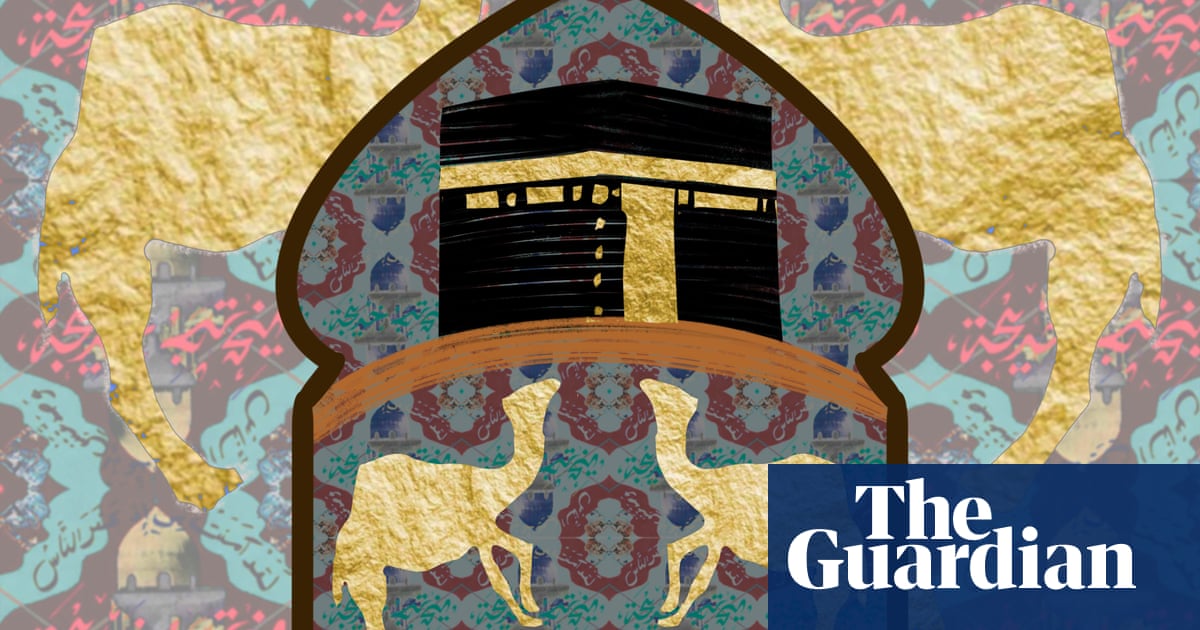
Show caption Detail from Khadijah, part of Women of Paradise by Farwa Moledina. Photograph: © Courtesy the artist Art and design A faith in fabric: can Farwa Moledina’s art change perceptions of Muslim women? Drawing on Islamic design, the Birmingham-based artist offers detailed, colourful depictions of female strength, bravery and independence Kadish Morris Mon 12 Sep 2022 08.00 BST Share on Facebook
Share on Twitter
Share via Email
Since moving to the UK from Dubai in 2010, Birmingham-based artist Farwa Moledina has set about reclaiming the narrative around Muslim women. “I think there’s an erasure of Muslim women in contemporary art. There’s a singular narrative that you find in museum and gallery spaces. There’s never an alternative presented.”
Moledina, who has exhibited work at Birmingham Museum and Art Gallery, the Midlands Art Centre and also as part of the Lahore Biennale, creates strong, intricate works that incorporate patterns, textiles and symbols. She is inspired by the work of the Moroccan photographer Lalla Essaydi, who is best known for her depiction of Arabic female identity, and also by the writer Edward Said’s critique of orientalism.
Her forthcoming exhibition, Women of Paradise at the Ikon Gallery in Birmingham, is inspired by the four women named by the prophet Muhammad as the Women of Paradise: Khadijah bint Khuwaylid, Fātima bint Muhammad, Maryam bint Imran, and Asiya bint Muzahim. “There’s something about each of their stories that are examples to us as Muslims. Their strengths, their bravery, their faith and their independence. They are role models.”
Moledina believes Khadijah’s story is particularly symbolic. She was the wife of Muhammad and was instrumental in spreading Islam. “She was a merchant. Prophet Muhammad was actually employed by one of her agents to go and do the selling. And on noticing his honesty and integrity, she proposed marriage to him,” Moledina says. “She supported him both emotionally and financially. This is a story of independence and endeavour that is inspiring for Muslim women. A lot of the time, the story you get is that Muslim women sit at home. They don’t work. They’re oppressed.”
I have a daughter now. I want to take her to museums and galleries and I want her to see herself
Moledina’s work always starts with a pattern. She then creates intricately detailed, often colourful and decorated artworks that are inspired by the distinctive characteristics of Islamic design: floral motifs, geometric designs and calligraphy.
At Ikon, there will be four wooden frames shaped in the form of a mihrab, an arched nook that indicates the direction of prayer towards Mecca. They are typically ornately decorated, and form the focal point of a mosque. In Moledina’s work, a mihrab will frame a silhouette of each of the four women, who wear a burqa or a chador. The surrounding patterns and embroidery will tell the story and identity of the women. “It takes a long time to design. I make 30 interactions of each pattern before I’m finally happy with it. A lot of it is small changes that most people wouldn’t notice,” says Moledina, “but the act of designing these patterns is almost meditative to me.”
Still, Moledina worries that by looking at the exotification of Muslim women, she could also end up tokenising them, too. “It’s quite a fine line that I need to navigate, to make sure that I’m making work about my lived experience, without orientalising myself,” she says. “With this work, I did feel a bit of responsibility. I have a daughter now. I want to take her to museums and galleries and I want her to see herself.”
Women of Paradise by Farwa Moledina is at the Ikon Gallery, Birmingham, to 13 November.
On a role: four works from Women of Paradise
Maryam, Farwa Moledina. Photograph: © Courtesy the artist
Maryam
“This piece alludes to Maryam mother of Isa, otherwise known as Mary, mother of Jesus. It is rare to find depictions of Mary in museum or gallery spaces outside the Christian imagination; she is always Mary, never Maryam. This work interrogates that assumption of neutrality by providing a different perspective on this figure. The silhouette takes inspiration from the typical composition of Mary and Jesus found within Christian religious paintings.”
Not Your Harem Girl, Farwa Moledina. Photograph: © Courtesy the artist
Not Your Harem Girl
“Inspired by the interiors in 19th-century orientalist paintings, Not Your Harem Girl aims to deconstruct the exotic and erotic orientalist tropes surrounding Muslim and eastern women. It particularly seeks to reclaim the orientalist concept of the harem. The pattern includes elements of Jean-Auguste-Dominique Ingres’s La Grande Odalisque, embroidered text with the phrase “Not Your Harem Girl” and a henna design of the same phrase.”
No One is Neutral Here by Farwa Moledina, at Lahore Biennale. Photograph: © Courtesy the artist
No One Is Neutral Here
“This piece is a digital print on polyester, and the fabric printed on fabric results in a pale and imprecise reproduction of the original photograph. It creates notions of figuratively pale reproductions of Muslim women within orientalist paintings and articulates my concern with the cultural construction and visual mediation of the “orient” by western male painters.”
Khadijah, Farwa Moledina. Photograph: © Courtesy the artist
Khadijah
“The wife of the prophet Muhammad, Khadijah was a merchant woman – she is a shining example of strength, faith and independence for Muslims. This piece features her tomb in Saudi Arabia before it was destroyed, verses from the Qur’an relating to her, and camels to symbolise her work as a merchant.”








